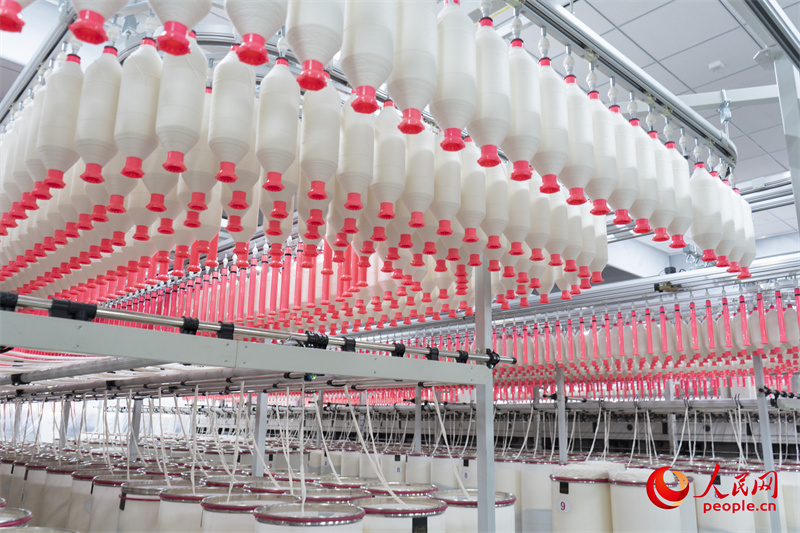Northwest China's Xinjiang Uygur Autonomous Region has harnessed its abundant natural resources and strategic location in the Belt and Road Initiative to develop the textile and garment industry. The region has transformed from a "cotton warehouse" into a major textile hub through the development of four comprehensive industrial bases.
Xinjiang has adopted a strategy emphasizing high-end, intelligent, green, and cluster-based development to advance the sector. In 2024, the industrial added value of textile and garment enterprises above a designated size increased by 1.67 times that of 2020, while the local cotton processing rate rose by 10 percentage points to 42 percent compared to 2020.

A view of a spinning workshop in the textile industrial park in Yining county, northwest China's Xinjiang Uygur Autonomous Region. (People's Daily Online/Chang Sha)
The textile and garment industry has become a key driver of high-quality employment and higher incomes for residents of all ethnic groups in Xinjiang.
At a company in Kashgar, Xinjiang, over 420 pieces of advanced automated denim processing equipment run at high speed. Over 500 workers are engaged in cutting, sewing, and pressing, working against the clock to fulfill an export order of over 100,000 garments. To boost capacity and product diversity, the company introduced a complete denim processing line this year, including washing, drying, and pleating systems, enabling it to produce more than 200,000 pairs of jeans each month for markets across Central and South Asia.
"Kashgar has both vertical integration capabilities, from cotton fields to finished garments, and unique geographical advantages, making it fully qualified to serve as a benchmark for the denim industry in western China," said Xie Qing, executive vice president of the China National Garment Association, during a research visit.
Xinjiang now boasts a complete industrial chain covering cotton, chemical fibers, spinning, weaving, dyeing and printing, apparel, home textiles, and industrial textiles. The region ranks first nationwide in cotton production, while its output of cotton yarn, viscose fiber, and cotton fabric ranks among the top five in the country. The China Cotton and Cotton Yarn Trading Center has also officially begun operations.
According to data from Tianyancha.com, a database query platform, Xinjiang currently has more than 400 textile and garment-related enterprises, with registration records indicating that 62.7 percent of them were established within the past five to 10 years.
"I can work at the factory right from home and earn 3,500 yuan ($492.12) per month. Life is getting better and better," said Ayitonghan Maimaiti, an employee at a garment company in Akto county, Kizilsu Kirgiz Autonomous Prefecture, Xinjiang.
As a key investment project in Akto town, the company has benefited from a supportive policy package including three years of free rent and equipment subsidies.
"At first, we had only about 20 workers and 50 old sewing machines. Now, with policy support, we have replaced them with new, much more efficient equipment," said Li Yan, the company's head. An automatic cutting bed introduced last year has increased the company's daily output to more than 1,200 pieces.
In the company's workshop, 320 female workers of the Kirgiz ethnic group were busy producing a new batch of trousers. Li said that these skilled women have become the backbone of the company. In the first half of this year, the company received orders for 1 million garments, including up to 400,000 pairs of trousers, with products exported to Japan, Europe, the Middle East, and other regions.
The Kashgar prefecture has extended and strengthened the textile and garment industry chain, promoting growth in cotton seed processing, high-end grey fabric production, dyeing, and printing. Seven relevant industrial parks in Kashgar have created around 70,000 jobs, with local residents accounting for 82 percent of employees.
According to Gao Huabin, deputy director of the Industry and Information Technology Department of the Xinjiang Uygur Autonomous Region, the complete industrial chain of the cotton textile and garment sector has preliminarily achieved the goal of creating about 1 million jobs, effectively facilitating the interaction, exchange, and integration of various ethnic groups.
"The garment sector needs more supporting industries. Initially, Xinjiang's garment sector focused mainly on contract manufacturing, but now many local brands are gaining market share," said Zhang Lijie, a professor at the School of Economics and Management of Xinjiang University.
Xinjiang Tangjin Textile Co., Ltd., with over 4,200 employees, has put 7,500 sock machines into operation, producing approximately 2.5 million pairs of mid-to-high-end cotton socks daily. Its products are exported to 22 countries. In 2024, the company achieved an output value of 350 million yuan and a sales revenue of 360 million yuan.
By the end of 2024, southern Xinjiang's spinning capacity accounted for 75 percent of the region's total, while looms made up more than 64 percent.
(Source: People's Daily)
